Research - (2021) Volume 9, Issue 2
Awareness on Time Management Techniques among College Students
Kandhal Yazhini P, Vishnu Priya V* and Gayathri R
*Correspondence: Vishnu Priya V, Department of Biochemistry, Saveetha Dental College and Hospitals, Saveetha Institute of Medical and Technical Sciences (SIMATS), Saveetha University Tamilnadu, Chennai, India, Email:
Abstract
Time management is the art of arranging, organizing, and scheduling one’s time for generating more effective and productive work. It is priority-based allocation and distribution among competing demands since time cannot be stored, and its availability cannot be increased beyond 24 hrs. Prioritization of tasks may make studying less overwhelming and more enjoyable. Academic stress and frustration occur when students feel the pressure of educational commitments, cramming for exams, rushing through homework, and getting minimal sleep due to disorganization of your time. The aim of this survey is to study the awareness of time management skills and perceived academic achievements among college students. Questions were prepared and administered to 110 participants through survey planet, an online survey link. 51.90% of participants possessed moderate to low level time management scores. 24.1% of the participants never wrote a set of goals for themselves for each day and 21.5% never spent time for each day planning. Whereas 48% always keep their desk beyond everything aside from what they are performing on, 40.5% sometimes review their class notes, 37.9% sometimes make a schedule of the activities that they need to try to do on workdays. To conclude, more than half of the students have shown only moderate time management skills. Majority of the respondents do not always plan their day before they begin it and not always spend time every day. Less than half of the students have a set of goals for the whole academic year. To improve academic performance, students need programs in relation to time management.
Keywords
Time management, Academic stress, Work, Daily priority, Academic performance
Introduction
Time management can be defined as the skill of organizing and prioritizing how to divide the person’s time between specific activities. Good time management helps a person to work smarter – not harder–so that he gets more done in less time, even when time is tight, and pressures are high. Failing to manage the time reduces the effectiveness of the person and causes stress [1]. The in-depth analysis of time management concepts reveals that managing time effectively means the act of directing and executing the tasks at hand, aimed at efficiency. There is an enormous amount of work done on this subject and numerous techniques have been advised on how to effectively manage the time, which is a discret, limited source for everyone [2]. Almost all of them suggest this following pattern: Single out the needs and wants, line them up in the order of their importance and priority and assign the time and resources accordingly for each one-off them, and stick to the plan. The concept of time management is said to have been proposed by Frederik Winslow Tayler as the tool for analysing the work pattern of the workers and reducing the unproductive and time-wasting tasks [3]. Time management is a self-discipline practiced by the person with a clear-cut focus on what to do at any given period, how much time to allocate for the particular activity, and how the tasks can be completed more efficiently [4]. The time management process in general consists of three parts: Short range planning, long range planning and time outlook. Short term planning refers to the planning of the activities that need to be completed in the short term, that is within a day or week. Long range planning is the ability to plan and handle everyday works over a longer time basis by being watchful of important dates and setting objectives, Time outlook is more of a state of mind with a focus on the effective utility of time. Time is a fundamental asset everybody has equally yet neglected to use at a similar level because of an assortment of reasons [5]. Time management is related to arranging and controlling over the measure of time spent on specific activities for improvement of more effective and efficient work [6]. Time management is a priority-based allocation and distribution among competing demands since time cannot be stored, and its availability cannot be increased beyond 24 hours [7].
Effective time management may reduce academic stress and frustration due to disorganization of time [8]. Increase of workload, may cause time pressure which has been found as a major cause for stress [9]. Time management behaviours related positively to perceived control of time, job satisfaction and health. It is negatively related to stress [10]. Implementing a realistic time management plan can improve productivity and quality of life [1,11]. The people who spend their time efficiently, priorities, plan and organise their time and work, stop procrastinating, minimise and manage social media may get successful in their job and get satisfaction in whatever they do [12].
Technology plays a major role as an effective tool for managing the time at the same time Technology can also cause distraction and affect a person's time management skills [13]. Priority setting, planning the day and studies as time management tools has been analysed in this study. Previous studies on cancer biology, nano materials, herbal products [14-18] have motivated me to pursue this current research which is useful to our community. The aim of this study is to study time management skills and to create awareness on time management techniques among college students.
Materials and Methods
Study design, area, and study population
A survey was conducted among dental undergraduates. The sampling from this survey is about 100. Participants in the age group of 17-25 years are considered. Participants in this survey are volunteers and no incentives were provided to the participants.
Sampling
The sampling method is simple random sampling. The measure to be taken to minimise sampling bias are survey software participants are randomly selected and avoid asking irrelevant questions. The internal validity depends on the independent variable. The external validity is to justify results. Questionnaire was prepared with the objective of finding out the awareness of time management techniques among college students. This was shared online through a survey planet. The participants who undertook the survey were college students from various colleges. They were encouraged to answer the set of questions which majorly targeted the distraction pattern during lecture class.
Result and Discussion
The findings of this study provide a transparent understanding of participants’ time management for this sample of students. This section shows the results obtained using our questionnaire survey. 43.3% students have agreed that they use their time efficiently and the remaining 56.8% of the students agreed that they were not using their time efficiently (Figure 1). 69.5% of the students answered that they did things in order of priority and 30.5% of the students answered in negative (Figure 2). When asked whether they set their goals, 65.3% agreed that they always set goals and the remaining 34.7% said no that they do not set their goals (Figure 3). For the question, do you prepare a daily “to do” list? majority (57.6%) said no whereas 42.4% said yes, they do (Figure 4). 67.8% of the students have agreed that they force themselves to make time for planning and 32.2% students have not agreed for the same (Figure 5). 44.9% students agreed that they will be able to meet the deadlines without rushing at the last minute, but 55.1% students disagreed (Figure 6). 40.7% students agreed that they keep up-to-date on their readings and homework whereas majority, 59.3% students said they do not maintain the same (Figure 7). Majority, 83.1% students are planning their time to relax and to be with friends and family, but 16.9% students answered that they do not plan such time (Figure 8). 54.2% allocate and control their time spent on social media on the other hand 45.8% disagreed (Figure 9). 58.5% students confirmed that they make constructive use of their travelling time and 41.5% students said that they do not make use of their travelling time (Figure 10). 63.6% students agreed that they avoid spending too much time on trivial matters and 36.4% answered disagreed for the same (Figure 11). When asked whether they try to do the most important task during your most energetic period of day, 78.8 % students agreed and 21.2% disagreed (Figure 12). For the question, do you prioritize the work in order of importance? the highest of 83.1% students answered that they prioritize their work in order of importance and 16.9% students answered no for the same (Figure 13). 64.4% students agreed that they periodically reassess their activities in relation to goal set whereas 35.6% students said that they do not reassess (Figure 14). Regarding the question, do you have a clear idea of what you want to accomplish during this academic year? 70.3% students agreed that they do but 29.7% students disagreed that they don’t have a clear idea regarding the same (Figure 15).
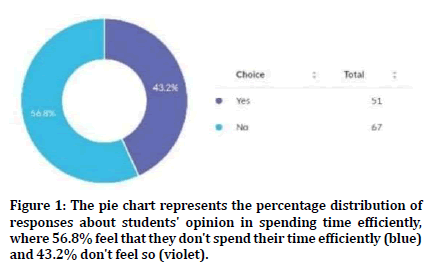
Figure 1. The pie chart represents the percentage distribution of responses about students' opinion in spending time efficiently, where 56.8% feel that they don't spend their time efficiently (blue) and 43.2% don't feel so (violet).
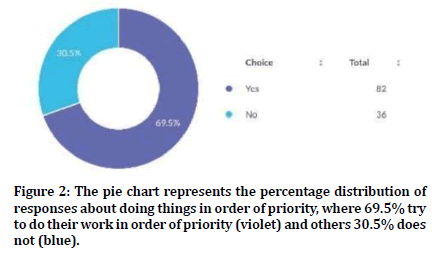
Figure 2. The pie chart represents the percentage distribution of responses about doing things in order of priority, where 69.5% try to do their work in order of priority (violet) and others 30.5% does not (blue).
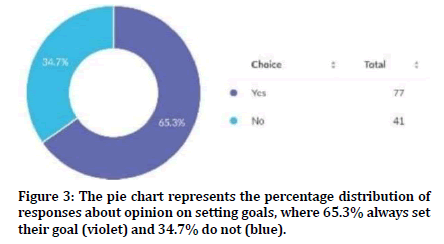
Figure 3. The pie chart represents the percentage distribution of responses about opinion on setting goals, where 65.3% always set their goal (violet) and 34.7% do not (blue).
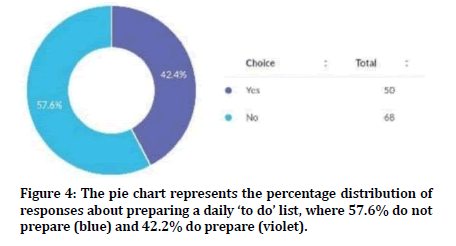
Figure 4. The pie chart represents the percentage distribution of responses about preparing a daily ‘to do’ list, where 57.6% do not prepare (blue) and 42.2% do prepare (violet).
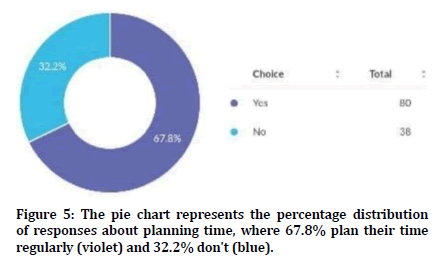
Figure 5. The pie chart represents the percentage distribution of responses about planning time, where 67.8% plan their time regularly (violet) and 32.2% don't (blue).
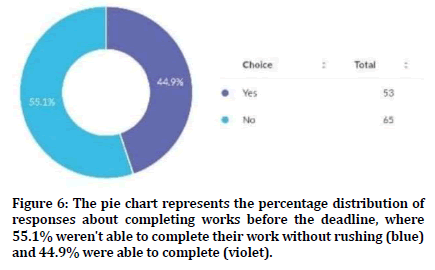
Figure 6. The pie chart represents the percentage distribution of responses about completing works before the deadline, where 55.1% weren't able to complete their work without rushing (blue) and 44.9% were able to complete (violet).
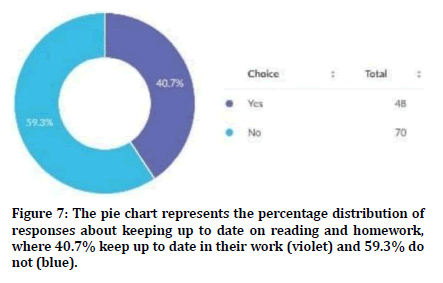
Figure 7. The pie chart represents the percentage distribution of responses about keeping up to date on reading and homework, where 40.7% keep up to date in their work (violet) and 59.3% do not (blue).
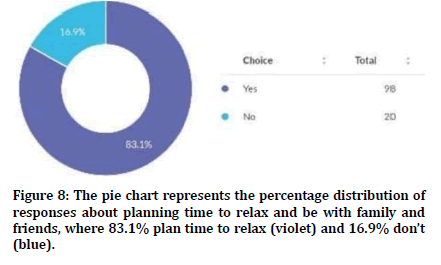
Figure 8. The pie chart represents the percentage distribution of responses about planning time to relax and be with family and friends, where 83.1% plan time to relax (violet) and 16.9% don’t (blue).
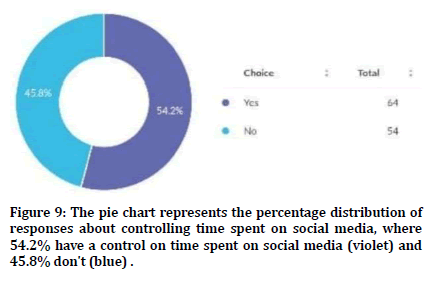
Figure 9. The pie chart represents the percentage distribution of responses about controlling time spent on social media, where 54.2% have a control on time spent on social media (violet) and 45.8% don't (blue) .
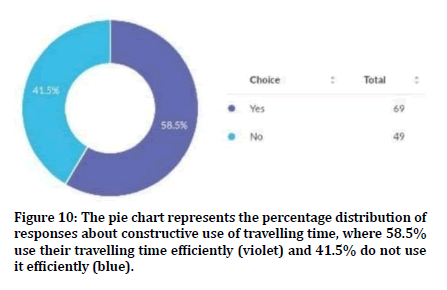
Figure 10. The pie chart represents the percentage distribution of responses about constructive use of travelling time, where 58.5% use their travelling time efficiently (violet) and 41.5% do not use it efficiently (blue).
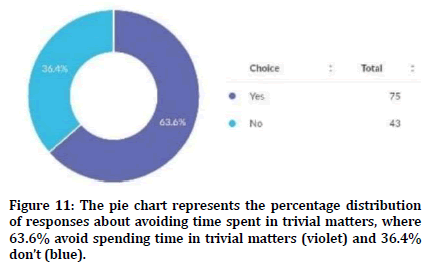
Figure 11. The pie chart represents the percentage distribution of responses about avoiding time spent in trivial matters, where 63.6% avoid spending time in trivial matters (violet) and 36.4% don’t (blue).
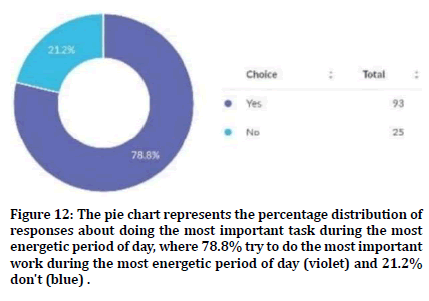
Figure 12. The pie chart represents the percentage distribution of responses about doing the most important task during the most energetic period of day, where 78.8% try to do the most important work during the most energetic period of day (violet) and 21.2% don't (blue) .
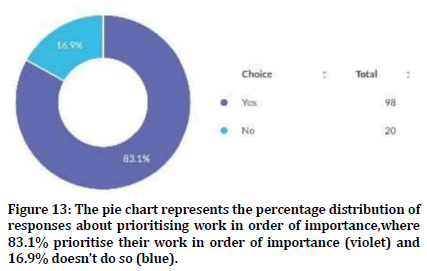
Figure 13. The pie chart represents the percentage distribution of responses about prioritising work in order of importance,where 83.1% prioritise their work in order of importance (violet) and 16.9% doesn’t do so (blue).
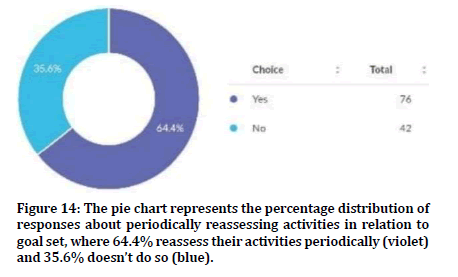
Figure 14. The pie chart represents the percentage distribution of responses about periodically reassessing activities in relation to goal set, where 64.4% reassess their activities periodically (violet) and 35.6% doesn’t do so (blue).
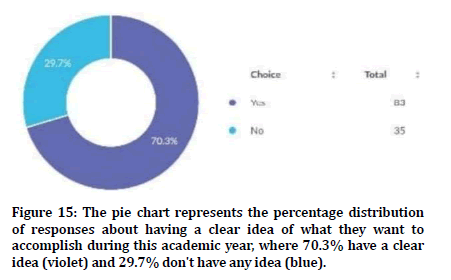
Figure 15. The pie chart represents the percentage distribution of responses about having a clear idea of what they want to accomplish during this academic year, where 70.3% have a clear idea (violet) and 29.7% don't have any idea (blue).
In the previous study by kaushar et al. it has been found that only 34% spend 6 hours in studying [5]. Previous study by Rai et al. on impact of time management on academic performance, it has been found that the majority population (72%) fail to manage their work and time and only 28% manage it effectively [19]. Ghiasvand et al. in his study observed that 49% of the population had a moderate level of time management skill [20]. Efficiency of time management training may increase the academic score and reduce the stress and frustration of the students [21]. The successful students are effective time managers [22]. Time management skills improve daily activity performance [23]. A few limitations that can be seen in the research is that the sample size (110 participants) is minimum, so the results may vary with other research. This study gives different information about time management and its effect in life. Future, this survey could be extended among different types of population with large sample sizes.
Conclusion
To conclude, more than half of the students have shown only moderate time management skills. Students who obtained higher percentages of marks also had high scores on general time management and their dimensions especially in short range planning. Approximately only about half of the students always set and honor priorities, emphasizing the common truism that the students do not essentially do things in order of priority. More than half of the students do not always plan their day before they begin it and do not allocate time for planning the day, on everyday basis. More than half of student’s reasses their work periodically according to their goal set. Less than half of the students have a set of goals for the whole academic year. 56.8 % of the participants feel that they do not use their time efficiently and 45.8% do not have control on time spent over social media. To improve academic performance, students need programs in relation to time management.
Acknowledgement
The authors would like to thank Saveetha Dental College for extending full support to complete this study.
Conflict of Interest
Nil.
References
- Vennila A. Time management is life management: A review article. Int J Trend Scientific Res Develop 2018; 4.
- http://encompass.eku.edu/cgi/viewcontent.cgi?article=1147&context=honors_theses
- Jackson VP. Time management: a realistic approach. J Am College Radiol 2009; 6:434–436.
- Lay CH, Schouwenburg HC. Trait procrastination, time management. J Social Behavior Personality 1993; 8:647–662.
- Kaushar M. Study of impact of time management on academic performance of college students. J Business Management 2013; 9:59-60.
- Britton BK, Tesser A. Effects of time-management practices on college grades. J Educ Psychol 1991; 83:405.
- Adebayo FA. Time management and students academic performance in higher institutions, nigeria a case study of ekiti state. Int Res Educ 2015; 3:1-2.
- Frazier TW, Youngstrom EA, Glutting JJ, et al. ADHD and achievement: Meta-analysis of the child, adolescent, and adult literatures and a concomitant study with college students. J Learning Disabilities 2007; 40:49-65.
- Al Majali S, AlKhaaldi K. Values of tolerance in relation to academic achievements, cultures, and gender among UAE universities students. Int J Instruction 2020; 13:571-586.
- Karakose T. The relationship between medical students’ time management skills and academic achievement. Studies Ethno Med 2015; 9:19-24.
- Boixados M, Hernandez E, Fernandez MP. Personal time-management and quality of life in the network society. Chapters 2012.
- Cyril AV. Time management and academic achievement of higher secondary students. J School Educ Technol 2015; 10:38-43.
- Olowookere EI, Alao AA, Odukoya JA, et al. Time management practices, character development and academic performance among University undergraduates: Covenant University experience. Creative Educ 2015; 6:79-86.
- Ke Y, Al Aboody MS, Alturaiki W, et al. Photosynthesized gold nanoparticles from Catharanthus roseus induces caspase-mediated apoptosis in cervical cancer cells (HeLa). Artificial Cells Nanomed Biotechnol 2019; 47:1938-1946.
- Ma Y, Karunakaran T, Veeraraghavan VP, et al. Sesame inhibits cell proliferation and induces apoptosis through inhibition of STAT-3 translocation in thyroid cancer cell lines (FTC-133). Biotechnol Bioprocess Eng 2019; 24:646-652.
- Wu F, Zhu J, Li G, et al. Biologically synthesized green gold nanoparticles from Siberian ginseng induce growth-inhibitory effect on melanoma cells (B16). Artificial Cells Nanomed Biotechnol 2019; 47:3297-3305.
- Ramya G, Priya VV, Gayathri R. Cytotoxicity of strawberry extract on oral cancer cell line. Asian J Pharm Clin Res 2018; 11:353–355.
- Menon A, Priya PV, Gayathri R. Preliminary phytochemical analysis and cytotoxicity potential of pineapple extract on oral cancer cell lines. Asian J Pharm Clin Res 2016; 9:140–143.
- Rai A. A study of impact of time management on academic performance of students studying in school. Indian J Res 2016; 5.
- Ghiasvand AM, Naderi M, Tafreshi MZ, et al. Relationship between time management skills and anxiety and academic motivation of nursing students in Tehran. Electronic Physician 2017; 9:3678.
- Yilmaz İ, Yoncalik O, Bektaş F. Relationship between the time management behaviour and academic success. J New World Sci Academy 2010; 5:187-194.
- Oyuga PA, Raburu P, Aloka PJO. Relationship between time management and academic performance among orphaned secondary school students of Kenya. Int J Applied Psychol 2016; 6:171–178.
- Khan IA. Time management paractices used by secondary school heads in Khyber Pakhtunkhwa. Gomal University, DI Khan 2017.
Author Info
Kandhal Yazhini P, Vishnu Priya V* and Gayathri R
Department of Biochemistry, Saveetha Dental College and Hospitals, Saveetha Institute of Medical and Technical Sciences (SIMATS), Saveetha University Tamilnadu, Chennai, IndiaCitation: Kandhal Yazhini P, Vishnu Priya V, Gayathri R, Awareness on Time Management Techniques Among College Students, J Res Med Dent Sci, 2021, 9 (2): 243-248.
Received: 23-Sep-2020 Accepted: 15-Feb-2021
